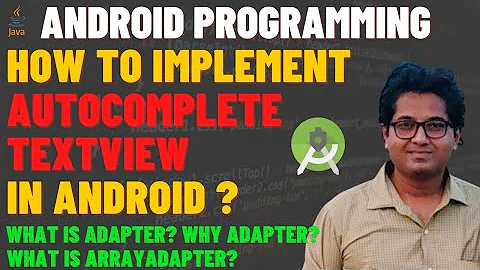What's the difference between BaseAdapter and ArrayAdapter?
Solution 1
Here is the difference:
-
BaseAdapteris a very generic adapter that allows you to do pretty much whatever you want. However, you have to do a bit more coding yourself to get it working. -
ArrayAdapteris a more complete implementation that works well for data in arrays orArrayLists. Similarly, there is a relatedCursorAdapterthat you should use if your data is in aCursor. Both of these extendBaseAdapter.
If your data is in a specialized collection of some sort or if you don't want the default behavior that ArrayAdapter provides, you will likely want to extend BaseAdapter to get the flexibility you need.
The performance of each really depends on how you implement them or change their behavior. At their core, either one can be just as effective (especially considering that an ArrayAdapter is a BaseAdapter).
You can do pretty much whatever you want with any adapter, but keep in mind that BaseAdapter is abstract, so you can't use it directly.
Solution 2
BaseAdapter is abstract while ArrayAdapter extends BaseAdapter (it is a concrete implementation of a BaseAdapter). If you extends for ArrayAdapter you are inheriting all the ArrayAdapter's features and, override its implementation you can modify the ArrayAdapter behavior. If you extends BaseAdapter you must implements all the Abstract methods, that ArrayAdapter already implements.
Also, does it affects the performance of the ListView
no it does not.
And, the last question is, can i achieve anything doing with ListView using any of these Adapters, or, there are certain cases where specific adapter only can be used ?
If the implementation in the SDK fulfill your needs why you need to override it and re-invent the wheel?
The main difference between them is that BaseAdapter can not be instantiate while ArrayAdapter can
Solution 3
In response to your 3 questions:
(1) BaseAdapter, according to the Android docs, is just a superclass of a number of adapter types, one of which is ArrayAdapter. There are a number of other adapters that are derived from BaseAdapter that fit different purposes. As a result it is unlikley there is any difference in efficiency between the two; you just get access to a different set of functions/methods with the various subclasses.
(2) The efficiency of your ArrayAdapter depends on the efficiency of what you're doing inside that class, i.e. the processing of bitmaps and other data.
(3) You could probably figure out a way to work your ListView using a different kind of adapter, however, the reason ArrayAdapter works is because it usually makes sense given the goal is to build an interactive list. The ArrayAdapte takes an Array, usually an ArrayList of objects, that it then processes to create the backing information for the ListView. In that sense the set up of ArrayList --> ArrayAdapter --> ListView just logically makes sense.
Solution 4
One more difference between BaseAdapter and ArrayAdapters is, if you extend array adapter you have to call super class constructor in the subclass constructor.
UserListAdapter extends ArrayAdapter<String>{
List<String> UserList;
Context context;
public UserListAdapter(Context context, int resource,List<String> listUsers) {
super(context, resource, listUsers); /* Super class constructor is called */
UserList = listUsers;
this.context = context;
}
}
But there is no super class for BaseAdapter. As BaseAdapter serves as super class for all other adapters
UserListAdapter extends BaseAdapter{
List<String> UserList;
Context context;
public UserListAdapter(Context context, int resource,List<String> listUsers) {
/* No super class constructor */
UserList = listUsers;
this.context = context;
}
}
Solution 5
private static final String[] COUNTRIES = new String[]{
"Afghanistan", "Angola", "Australia", "Bangladesh", "Belgium",
"Bhutan", "Brazil", "Canada", "China", "Denmark"
};
ArrayAdapter<String> adapter = new ArrayAdapter<>(this, android.R.layout.simple_dropdown_item_1line, COUNTRIES);
AutoCompleteTextView textView = (AutoCompleteTextView) findViewById(R.id.countries_list);
textView.setAdapter(adapter);
Here we can't use BaseAdapter like ArrayAdapter.
Related videos on Youtube
Chintan Soni
Hey visitor, Greetings !!! I am Chintan Soni, a Passionate, Tech savvy, Independent, Self-motivating Mobile Application Developer. Currently serving as TechLead - Android @ ARInspect. Always eager to learn new technologies. Love to help people learn with, whatever I got. Meet my brother: Yash Soni A tech-enthusiast, Gadget Freak and Apple Fanboy. Motto that LIT my life: Learn, Implement and Teach others. Github: https://github.com/iChintanSoni Medium: https://medium.com/@chintansoni My Mentor: Paresh Mayani, Pratik Patel Currently onto: Flutter Kotlin Platforms and Frameworks I have worked on: Android Native Application Development Ionic 3.x Application Development Microsoft ASP.net Web Api 2 using Entity Framework 6.1 (MSSQL Server Database 2014) Node.js (MySQL Server) Google Firebase Augmented Reality Facebook Messenger Bots And what not...!!! Follow me on: Facebook, Twitter, LinkedIn
Updated on December 16, 2020Comments
-
 Chintan Soni over 3 years
Chintan Soni over 3 yearsI want to know the difference between using
BaseAdapterandArrayAdapter.I have been achieving what I want through
ArrayAdapters.Does it affect the performance of the
ListViewon the adapter interface in which it is implemented ?And, the last question is, can i achieve anything doing with
ListViewusing any of theseAdapters, or, there are certain cases where specific adapter only can be used?-
 Raghunandan almost 11 yearsdeveloper.android.com/reference/android/widget/…. ArrayAdpter. developer.android.com/reference/android/widget/BaseAdapter.html. BaseAdapter. ArrayAdapter is a concrete sub class of BaseAdapter
Raghunandan almost 11 yearsdeveloper.android.com/reference/android/widget/…. ArrayAdpter. developer.android.com/reference/android/widget/BaseAdapter.html. BaseAdapter. ArrayAdapter is a concrete sub class of BaseAdapter -
 Pragnani almost 11 yearsSimply ArrayAdapter is already constructed, we just need to use it. but the BaseAdapter is more generic adapter for which we need to provide implementation .(getView(),getcount() etc methods in Adapter)
Pragnani almost 11 yearsSimply ArrayAdapter is already constructed, we just need to use it. but the BaseAdapter is more generic adapter for which we need to provide implementation .(getView(),getcount() etc methods in Adapter)
-
-
 John about 9 yearsAnd no need on DataType Specified in BaseAdapter like in ArrayAdapter. Example : ArrayAdapter<String>
John about 9 yearsAnd no need on DataType Specified in BaseAdapter like in ArrayAdapter. Example : ArrayAdapter<String> -
 Selvin almost 9 yearsalso you should never use
Selvin almost 9 yearsalso you should never useList<T> UserList;in the class which extendsArrayAdapter<T> -
Felix over 7 yearsThe default behavior that
ArrayAdapterprovides (as mentioned by @tanis-7x ) is that there can be only 1TextViewinside the list item, actually very limited behavior. If there are multiple controls in each list item, you must useBaseAdapterand to the job by yourself. Of course you can still useArrayAdapter, becauseArrayAdapteris aBaseAdapter.






